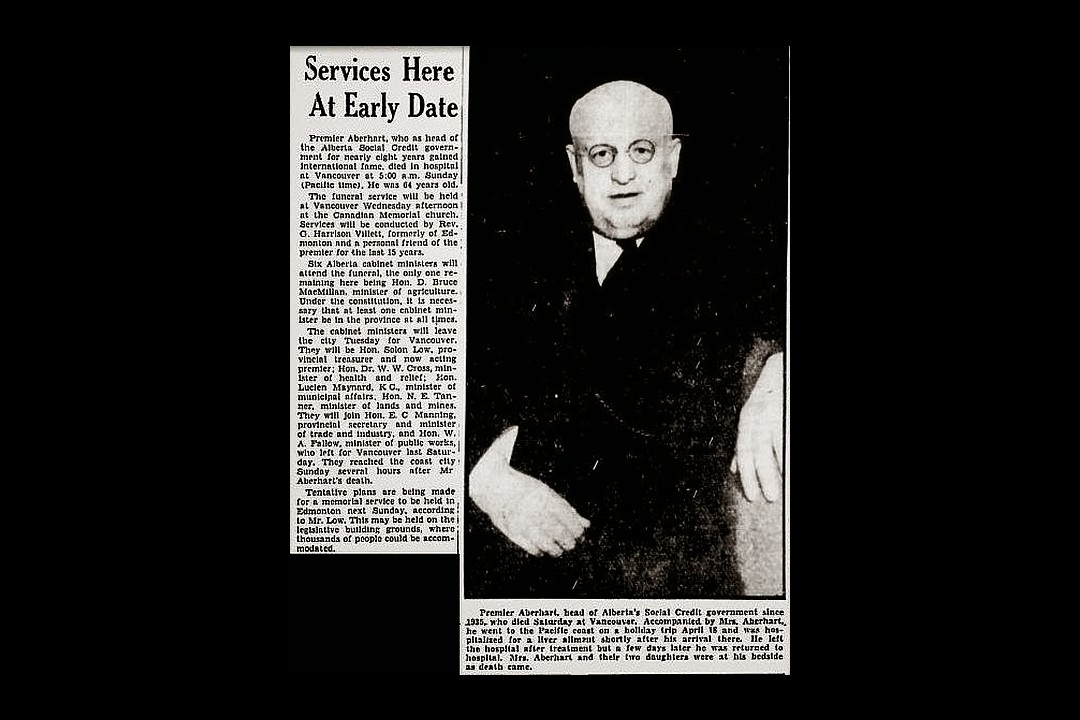On this day in 1943, funeral services were planned for William Aberhart, one of Alberta's most infamous public figures.
Even before he entered politics, William "Bible Bill" Aberhart had a following. While his day job was that of a Calgary school principal with a reputation for strict discipline, most knew Aberhart for his Sunday sermons broadcast on CFCN.
In the 1930s, the Great Depression hit Alberta hard. Aberhart had become fascinated by social credit theory, an obscure economic idea arguing the lack of purchasing power among the public was the cause of the depression. While social credit adherents worldwide began seeking power, Aberhart was able to mix the theories with his own version of fire-and-brimstone social conservatism to create the first political party to follow the idea. The Social Credit Party of Alberta was born.
During the election of 1935, Aberhart and the SoCreds pledged to provide every Albertan adult with a payment of $25 per month, as well as other debt-relief measures to ease the province's economic suffering. This struck a chord with voters, and that year, the SoCreds nearly swept the election — 56 of 63 seats went for Aberhart.
Pitching social credit plans proved easier than actually implementing them. Aberhart found that provincial coffers didn't have enough for his monthly payments. Eventually, his government issued "prosperity certificates" to people working on provincial public works projects. The Alberta scrip wasn't cash, but the promise was that it could be exchanged for money after a specific time. The project proved very unpopular, with only a few merchants in Edmonton willing to take it. (Tellingly, the Alberta government wouldn't accept the certificates as tax payment.) The two-year experiment was axed after only one year.
Aberhart's governments also took aim at both banks and journalists. He proposed laws that would heavily tax and regulate banks in Alberta, as well as take control of the credit system. Never a fan of his critics, Aberhart also tried to push through measures that would levy draconian fines against media that were not sufficiently deferential to his government.
Alberta's lieutenant-governor blocked the bills, reserving royal assent until the Supreme Court of Canada could weigh in on them. The court deemed that Aberhart's plans overstepped the province's powers and would not be allowed. Afterward, Aberhart used his position to cut the lieutenant-governor's budget and staff, and he got rid of the position's official residence (which remains the case to this day.)
While Aberhart's immense popularity waned by the next election, it was still enough for the Social Credit Party to easily win again. Aberhart's second term was cut short when he died unexpectedly in 1943. Alberta's economic outlook improved drastically in the post-war years due to oil development. The Social Credit Party moved away from many of Aberhart's economic experiments and remained in power until 1971.
Though he served less than two full terms, Aberhart had a considerable impact on Alberta, both culturally and politically. The Aberhart Centre, a medical facility at the University of Alberta Hospital, bears his name today. Nearly 90 years after Aberhart's first election, Albertans are again heading to the voting booth — although a repeat of the 1935 landslide is unlikely, with polls predicting a close race between the UCP and the NDP.
This is based on a clipping found on Vintage Edmonton, a daily look at Edmonton's history from armchair archivist @revRecluse — follow @VintageEdmonton for daily ephemera via Twitter.

